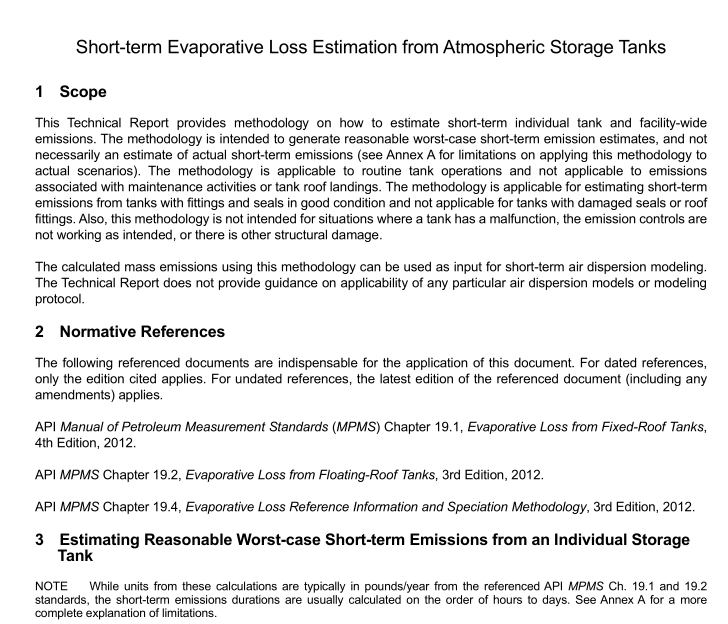API TR 2576 pdf download

API TR 2576 pdf download Short-term Evaporative Loss Estimation from Atmospheric Storage Tanks
3.4.3.2 Wind Speed The function of the fixed roof on an internal floating-roof tank and a domed external floating-roof tank is not to act as a vapor barrier, but to block the wind. Wind speed is a large contributor to emissions for external floating-roof tanks from the rim seals and deck fittings. Higher wind speeds will generate more emissions, but will also induce more dispersion. Lower wind speeds will generally have lesser emissions but with less dispersion. Seasonal archived wind data may be available from an airport or other local source, or from archived sources such as the United States National Solar Radiation Data Base (http://rredc.nrel.gov/solar/old_data/nsrdb/), or internationally, the NASA Surface Meteorology and Solar Energy Data Set (http://eosweb.larc.nasa.gov/sse/), or from API MPMS Ch. 19.4, 3rd Edition, Table 1. Follow the following steps.
Step 1: Calculate the maximum short-term working loss rate, LWD. Use API MPMS Ch. 19.2, Section 4.3.1, Equation (19) 5 to calculate annual working loss, L W , with:
— throughput calculated from the maximum withdrawal rate;
— liquid surface temperature, as determined from 3.1, for the month selected for standing loss in Step 2 below;
— divide this annual working loss by 8760 hr/yr to obtain the maximum short-term working loss rate, L WD . Step 2: Calculate the maximum short-term standing loss rate, L S .
— Use the API MPMS Ch. 19.2, Section 4.2.1, Equation (2) 5 to calculate standing loss for the rim seal, deck fittings, and deck seams (if bolted) on a monthly basis; — select the month with the highest estimated standing losses, accounting for both temperature and wind speed;
— divide this maximum monthly standing loss rate by the number of hours in the month to obtain the maximum short-term standing loss rate, L S .
Step 3: Sum the maximum short-term working loss rate, L WD , and the maximum short-term standing loss rate, L S , to obtain the total maximum short-term emission rate, L MAX , for an external floating-roof tank.
4 Estimating Reasonable Worst-case Short-term Emissions from a Battery of Storage Tanks
4.1 Overview It is highly unrealistic, and thus grossly conservative, to evaluate short-term emission rates from an entire facility on the basis that every tank is being filled simultaneously. For a more representative estimate of short-term emissions, the following considerations should be taken when estimating short-term emissions for a battery of storage tanks.
4.2 Overlaying Equipment Limitations
4.2.1 General When evaluating short-term emissions from a battery of tanks, consideration should be given to site limitations like pump rates, piping availability, control equipment limitations, and product storage. Overlaying site equipment limitations provide a more realistic evaluation of short-term worst-case hourly emission for the entire site.
4.2.2 Pumps Available pumps for a site at any given time should be considered when evaluating site-wide hourly emissions. Actively working tanks should be restricted to the number of both inbound and outbound pumps available for floating- roof tanks, and inbound pumps for fixed-roof tanks. Product transfer configurations vary and pumps may not be located at each tank or available for all tanks, so assuming that all tanks are “working” would grossly overestimate the short-term emissions from the site.
4.2.3 Piping Availability Available piping for a site at any given time should be considered when evaluating site-wide short-term emissions. Similar to pumps, tanks may be manifolded together and share inbound/outbound lines. Actively working tanks should be restricted to the volume of transfer capacity in the number of outbound pipes available for floating-roof tanks and inbound pipes for fixed-roof tanks. The piping availability should be overlaid with the pump availability and the restricting parameters should prevail.
4.2.4 Control Device A control device used either at the point of transfer or to control roof landing should be evaluated for availability and capacity/pump rates. There is often a limited number of control devices at a site with a restricted pump rate that should be considered when evaluate site-wide short-term emissions.
4.2.5 Combined Process Restrictions The piping availability should be overlaid with the pump availability and control device availability/pump rate and the restricting parameters should prevail. Operators may need to consider scheduled or concurrent maintenance activities for short-term emissions and restricting parameters where additional temporary controls (Vapor Combustor Unit [VCU] or Vapor Recovery Unit [VRU]) may or may not be deployed.
4.2.6 Product Storage Consideration should be given to what product can be stored in what tank, either by permit, by customer contract, tank construction type, and/or by physical site limitations. For example, gasoline may only be stored in floating-roof tanks and there is only one loading spot with a control device, so in this example, only one gasoline tank can be working at one time.









